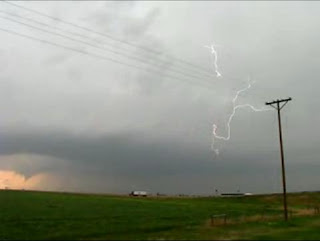
Since it's the middle of winter and I'm thinking a lot about storms, I thought I would post a few shots and some radar data from my tornado intercept last August. I'm glad to be back out on the Plains after being away for 4 years. .. Here's a view of the Alta Vista, CO tornado developing (view is from the west looking east). A nice RFD notch can be seen with a dust whirl developing underneath. The tornado was a mile to my east. The storm was a neat little LP supercell that had a very compact base as seen from Dann's shots on the other side of the storm. Note that the pictures were taken by an iphone camera. Not bad quality for a phone, huh. I wasn't prepared to chase on this day. Keri & Tommy were in Florida with our main camera and we had just moved back to CO from WA. All of our stuff was still in boxes. Anyways, it was a fun chase, got to see a tornado, and get some half way decent pictures.

Here's the Pueblo, CO radar image from 4:19 local time. The storm was very sheared out west to east and had no visible hook echoes. It was an LP storm with all of its precipitation well
downshear from the main updraft. There were also lots of surface boundaries in the vicinity. Once of which was a large north to south boundary that was likely a combined dry line - outflow boundary. This played a role in convective initiation and possibly
tornadogenesis.

Finally, here's a picture of the tornado when it was mature. The funnel was not visible from my perspective. Notice that swirl-like cloud above and left of the tornado... that was a long-lived feature on this storm and was likely the low level
mesocyclone. Rapid cloud based rotation was present for about an hour prior to the tornado. This was a very interesting storm from many aspects.


funnel.JPG)
niceRFD!.JPG)







